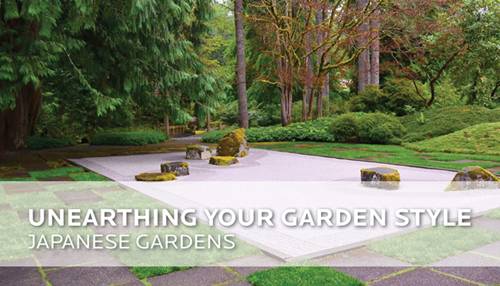Unearthing Your Garden Style - Japanese Gardens
- Font size: Larger Smaller
- Hits: 6212
- 2 Comments
- Bookmark
“What is your garden style?” This is not an easy question to answer when you are new to gardening.
(picture above The Bloedel Reserve)
I remember many Saturday afternoons looking at all the plants at the nursery and wanting them all but not having any idea on how to put them together in my own yard, much less understanding how the finished garden would look. It was like assembling a giant jigsaw puzzle without the benefit of the picture on the puzzle box.
I am going to let you in on a little secret; many of us who have had our hands in the soil for years are still discovering our personal garden style. Even when you know what a new garden’s style will be there are edits, tweaking and sometimes total revamps of the garden. And that is okay. Gardening is a lot of trial and error, whether you are a freshman gardener or have logged 30 plus years in the garden.
| Moving from one area of a garden to another over an arched bridge invites visitors of Japaneses gardens to reflect and acknowledge the transition. A very simple planting of maples, ground cover and a small stand of iris frames the gracefully arching bridge. Schedel Arboretum & Gardens |  |
In Unearthing Your Garden Style, I want to help you get a better feel of what it is you like in a garden style. I garden at a local park that has many small gardens of various styles. Myself, as well as the other gardeners, are asked countless garden questions by visitors and often times the crux of the issue is figuring out what type of garden the visitor would like to have in her own yard. Walking a visitor around the grounds I ask them what they like and don’t like about the various gardens. With these clues we piece together a garden style that speaks to them. Since we can’t walk about the park together in this blog we will explore one garden style at a time, unearthing the style, or styles, that speak to you.
First thing to know my new garden friends is very few gardens are purely one style; but, most gardens are influenced by a garden style of some sort. When you find a style you like, use that as your guide. As you get more comfortable in your own garden space add your own personal touches. There are no hard set rules to follow with the exception of one: grow the plants you love.
 |
Japanese Maples, conifers and expertly manicured walks and lawn set the stage for a stunning, red arch; a portal through which visitors pass when exploring the garden. Schedel Arboretum & Gardens |
Exploring Japanese Garden Style: Cool, calm, peaceful, orderly without being stiff, green, water and stone. These are words used time and again for Japanese gardens. What I love about this style of garden, especially for new gardeners, is there are few flowers in Japanese gardens. One of the trickiest things to learn is how to have continuous blooms in a garden- it can be a daunting at first. The second hurdle for many gardeners is learning how to create structure, the bones of the garden. The bones of the garden set the foundation for the rest of the garden and ensure the garden has winter interest. Winter interest can come from garden lines, statues, water features and trees and shrubs that are as beautiful in the winter as they are in the summer. With Japanese gardens we focus on structure, movement and texture and less so on blooms. Understanding the basics of Japanese gardens will benefit you well no matter what garden style you adopt.
The beauty of a Japanese garden comes from its use of trees, evergreen shrubs and ground cover, rocks, water and paths that twist and turn, revealing new vignettes or spaces within the garden that were hidden just a few steps earlier. The color found in a Japanese garden comes from the subtle differences in the greens of the foliage. If you find yourself drawn to hostas, ground covers like liriope, Pachysandra or ground ivy the foliage focused Japanese garden may be perfect for you. The Japanese garden is focused on texture as well as the architecture of trees and shrubs. When you look at small trees and shrubs are there those that draw you in and you find beautiful even when they are not leafed out? Japanese maples and corkscrew willows have fabulous shape and form, making them just as attractive in the winter as in the summer.
Less is more- is this your motto? Japanese gardens create a lush feel with the use of a few different plants. A large band of moss with a curved edge of flat river rock punctuated with a large stone or dwarf evergreen reflects Japanese garden style. Japanese garden design focuses on a few key pieces of art or garden structure, such as a cairn or stone pagoda placed in a way to create a focal point in the garden rather than a cluttered collection of tchotchkes.
| The entrance to the Bloedel Reserve's Japanese Garden on Bainbridge Island, WA sets the scene for calm, peace and tranquility. Stone, wood and a simple planting shows how a garden space can be lush and simple at once. The Bloedel Reserve |  |
A green garden, year round. You may be well suited for Japanese garden if you are drawn to the evergreens at the nursery, their textural variations and the feel of the needles and the look of some of the trees’ bark. Japanese gardens infuse evergreen plants for their year-round foliage of diverse shades of green and great textures. Evergreens are cool in the summer, many have a fabulous shape and architecture naturally, and with the help of selective pruning can provide a rich pallet of green in the cold, grey winter months.
Balance without symmetry. One half of Japanese garden is not a reflection of its other half. The gardens are balanced visually using stones, plants, structures or garden art.
Must add water. Water is an essential element of a Japanese garden. A small water feature, a stream, pond or the illusion of flowing water created by stones placed in a fish scale pattern is a signature element of a Japanese garden.
 |
This garden would be just as beautiful in the winter thanks to the architecture of the Japaneses maples, the cloud pruned pine coupled with the pond and its large rocks. Schedel Arboretum & Gardens |
What plants would I suggest that you plant in your Japanese Garden?
Heucheras are great, easy to find perennials for the Japanese inspired garden. Planted en masse, such as around a Japanese maple, the leave's unique shapes and colors add a wonderful texture to the garden while their small, dainty flowers perched on tender stems add soft movement. For your Japanese inspired garden, plant multiples of one variety from the HGTV HOME Plant Collection Heck-of-a Heuchera™ or Heucherella Reveal™ collections.
If you have dry shade garden, the lovely heart-shaped leaves of True Heart™ Brunnera is an excellent choice. The white of the leaves will draw the eye to the shade of the garden and the soft, pale blue flowers will not distract from the foliage infused design of the Japaneses garden.
All images by Jennifer Koester
Comments
-
 Friday, 23 May 2014
Friday, 23 May 2014JoAnn- for a someone who has never done this before you sounds like you are turning into quite the gardener! A covered swing would be lovely and a welcome retreat on many afternoons..you may need two! Perhaps, if you have room, flank the swing with patio trees(shorter trees) to give you a bit more shade around the swing, and extend the garden out on both sides. ~~ Jennifer Koester









I like the Bloedel Reserve Japanese Garden for where I live. I live in a 37 ft. fifth wheel right next to the landowner who lives in a large double wide mobile home.this all sits on three acres with no shade.I thought this garden or a variation of it would be pretty in front of the two homes.Out front just a little ways making a pretty visual for both homes.They are only 5 ft. apart.I thought of a wood covered porch swing somewhere in there.Opinions? advise? suggestions? As you can tell I've never done this.I have encircled hackberry trees with railroad ties, ends made like arrows.It was a raised bed and I put three azailias in between the trees. On the same property between the house and sidewalk that curved I planted a purple flowered rose of sharon and filled in with jew. They both turned out good.